It's funny how you just found out that your neighbor's pipes burst last winter, and now you're worried about your own home. As temperatures drop, the risk of frozen pipes increases, which can lead to costly water damage. You might think your plumbing is safe, but there are several proactive steps you can take to protect your home. By understanding what causes frozen pipes and implementing simple measures, you can avoid a potential disaster. What are the essential steps you need to evaluate to guarantee your home stays safe this winter?
Understanding Frozen Pipes
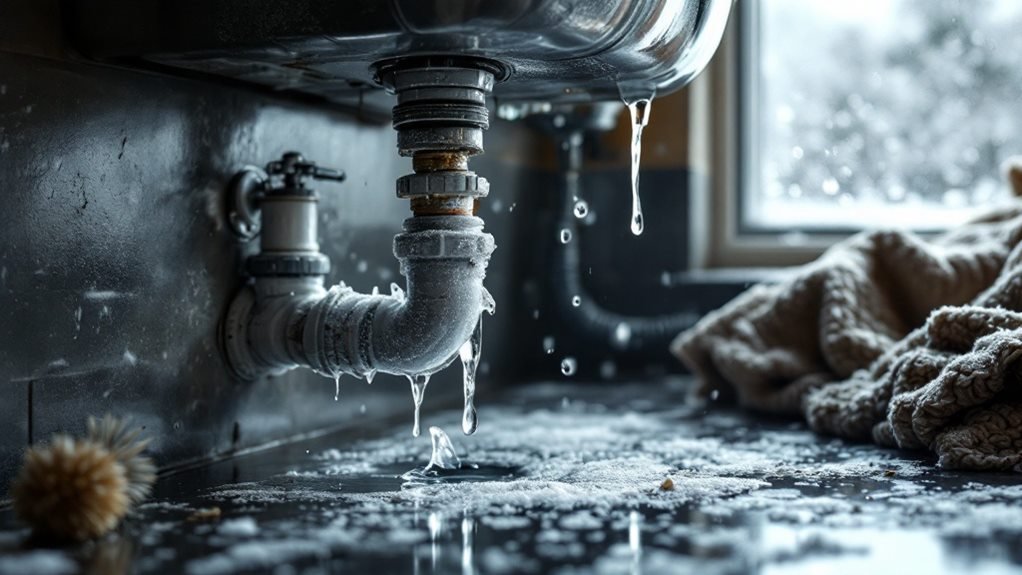
Understanding how frozen pipes occur is crucial for preventing damage to your home. When the temperature drops, the water inside your pipes can freeze, leading to pipe expansion and, ultimately, a burst pipe. Imagine your pipes throwing a winter party, and the water inside decides to freeze up and frolic like nobody's watching—except they are, and they're holding a hefty repair bill!
During winter preparation, you need to verify that your pipes are prepped too. Insulate any exposed pipes, especially those in unheated areas like basements or attics. You know, the places you forget exist until it's time to dig out the holiday decorations. Keeping your home warm and maintaining a consistent temperature can help prevent this icy disaster.
Another tip? Let your faucets drip a bit during extreme cold spells. It may feel like you're wasting water, but a little flow can prevent that "frozen pipe" frolic from happening. So, gear up for winter and give your pipes the warm hug they need to stay safe and sound. Trust us; your plumbing will thank you when spring rolls around!
Signs of Frozen Pipes
Once the temperature drops considerably, it's important to be aware of the signs that indicate your pipes may be freezing. First off, check for any unusual sounds. If you hear a faint gurgling or banging noise, it could mean trouble. You might likewise notice that your water pressure drops unexpectedly—like your pipes are playing a game of hide-and-seek.
Another telltale sign is frost forming on the exterior of your pipes. If your pipes are feeling icier than your ex's heart, it's time for some urgent action. Moreover, if you turn on the tap and only a trickle of water comes out, you've got a strong contender for the Frozen Pipe Olympics.
To prevent these icy woes, proper pipe maintenance is key. Insulate your pipes, especially those in unheated areas, and keep the heat on during extreme cold spells. Winter preparation isn't just about cozy blankets and hot cocoa; it's also about ensuring your plumbing is ready to face the chill. So, keep your eyes peeled for these signs, and you'll be one step ahead in the battle against frozen pipes!
Risks of Water Damage
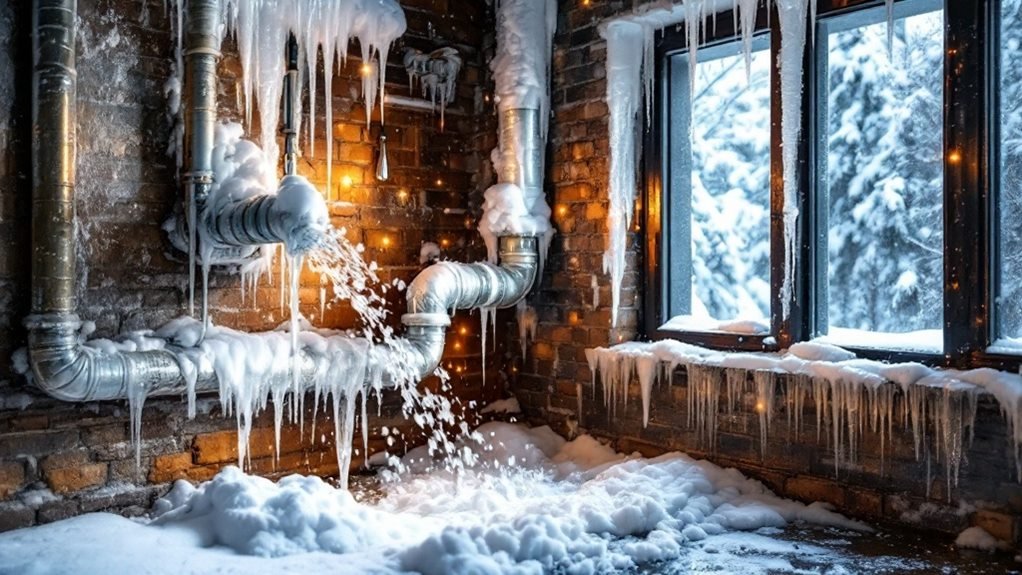
When pipes freeze and burst, the risks of water damage can escalate quickly, leading to costly repairs and significant disruptions in your home. A simple water leak can turn into a mini Niagara Falls, and trust me, that's not the kind of waterfall you want in your living room. The potential for mold growth increases with every drop that escapes, creating an unwelcome environment that can affect your health and your wallet.
Moisture control is crucial in preventing these disasters. If you ignore the signs of a leak, you might find yourself knee-deep in trouble—literally. Water can damage your walls, floors, and even your precious furniture. And don't forget about your electrical systems; water and electricity don't mix well, resulting in a shocking combination you want to avoid!
To keep your home safe, be proactive. Check for any signs of leaks, and make moisture control a priority. After all, a little prevention now can save you from a flood of regrets later. So, gear up and protect your home—because nobody wants to swim through their living room this winter!
Insulating Your Pipes
Insulating your pipes is essential for preventing freezing during cold months. You can choose from various insulation materials, such as foam sleeves or fiberglass, to suit your needs. Furthermore, understanding proper installation techniques will help guarantee maximum effectiveness in protecting your plumbing.
Types of Insulation Materials
Choosing the right insulation materials can greatly reduce the risk of frozen pipes in your home. Let's explore some options that'll keep your plumbing cozy even when it's frigid outside.
Spray foam insulation is a fantastic choice, as it expands to fill gaps, keeping your pipes snug and warm. Fiberglass batts are another popular option; they're easy to install and provide decent insulation without straining your budget. If you prefer something rigid, consider rigid foam insulation. It's tough, effective, and can handle whatever winter throws at it.
Cellulose insulation is eco-friendly and made from recycled materials, so you can save the planet while saving your pipes. Don't forget about reflective barriers, which reflect heat back into your home, perfect for those cold winter nights. Mineral wool is likewise a viable option, offering soundproofing benefits alongside thermal resistance.
Insulation Installation Techniques
Your home's plumbing system deserves careful attention to verify it stays warm and protected during the winter months. Insulating your pipes is a smart move that can save you from the headache of frozen pipes and costly repairs. Here are some effective insulation techniques to verify proper installation:
- Use Foam Pipe Insulation: This is a simple, effective way to insulate your pipes. Just cut it to size and wrap it around the pipes—easy-peasy!
- Apply Heat Tape: This electrical tape warms the pipe, preventing freezing. Just don't confuse it with your favorite craft tape!
- Insulate Your Attic and Basement: Don't leave your pipes out in the cold! Insulating the entire area keeps the ambient temperature up.
- Seal Cracks and Openings: Check for gaps around windows and doors. A little caulk can go a long way in keeping the warmth in.
Keeping Your Home Warm
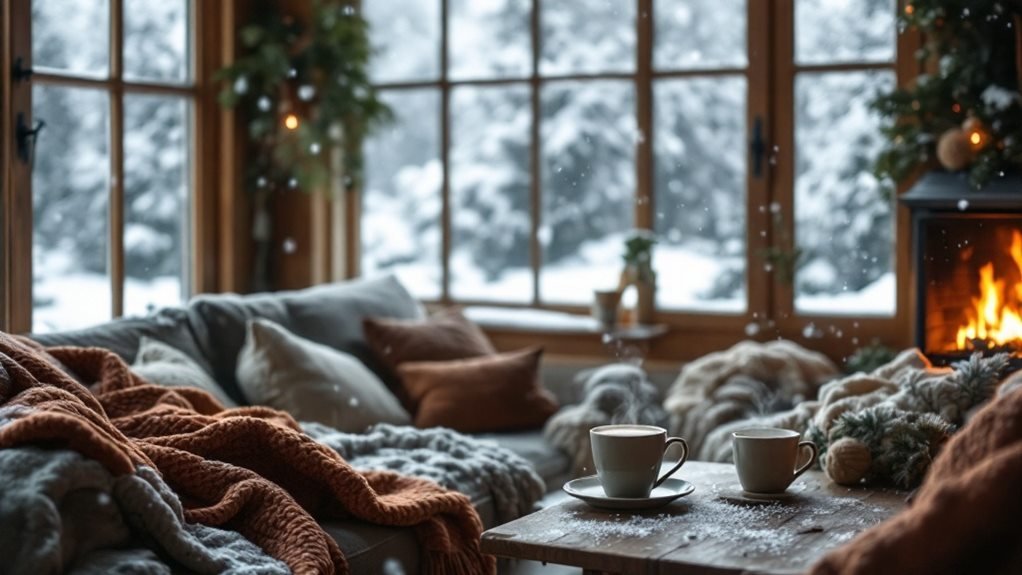
As winter approaches, maintaining a consistent indoor temperature is crucial to preventing frozen pipes. You don't want your pipes to resemble icicles, right? To keep your home warm, focus on effective home heating methods that maximize energy efficiency. Start by setting your thermostat to a minimum of 55°F, even when you're away.
If you've got a fireplace, let it do the heavy lifting; just remember to keep the flue closed when it's not in use, or you'll be heating the great outdoors. Confirm your heating system is well-maintained—replace filters regularly and schedule annual check-ups.
Consider using space heaters strategically in colder spots, but don't go overboard; they can be as energy-hungry as a teenager raiding the fridge. Seal gaps around windows and doors with weather stripping to keep the warmth in and the cold out.
Lastly, accept the power of curtains! Opening them during the day lets in natural sunlight, while closing them at night acts like a cozy blanket for your windows. Following these tips will help you stay warm and keep your pipes from turning into frosty waterworks this winter!
Draining Outdoor Faucets
Maintaining a warm environment inside your home isn't the only step in preventing frozen pipes; attention to outdoor plumbing is just as important. One essential aspect of faucet maintenance is draining your outdoor faucets before the winter chill hits. Here's how you can tackle this task like a pro:
- Turn off the water supply to your outdoor faucets. Locate the shut-off valve, usually found indoors, and twist it to the off position.
- Open the outdoor faucets to let any remaining water drain out. This prevents it from freezing and causing damage.
- Remove any hoses connected to the faucets. Hoses can trap water, turning your outdoor spigot into a mini ice sculpture if left attached.
- Insulate the faucets with foam covers or towels. Think of it as giving your pipes a warm winter coat!
Monitoring Temperature Fluctuations
To protect your home from frozen pipes, you need to be aware of temperature fluctuations. Monitoring tools, such as digital thermometers and smart home systems, can help you keep track of indoor and outdoor temperatures. By recognizing risky temperature patterns, you can take proactive measures to prevent freezing.
Importance of Temperature Awareness
A keen awareness of temperature fluctuations is crucial in safeguarding your home from the threat of frozen pipes. Ignoring those pesky temperature extremes can be the difference between a cozy winter and a soggy mess. Here's what you need to keep in mind:
- Temperature Mapping: Identify the cold spots in your home where pipes are most vulnerable.
- Seasonal Changes: Pay attention to how the weather shifts—those warm days can trick you into complacency.
- Indoor Heating: Confirm your heating system works efficiently, especially in areas where pipes are located.
- Routine Checks: Regularly monitor for dips in temperature during the night or unexpected cold snaps.
Tools for Monitoring Temperatures
Monitoring temperature fluctuations in your home is critical for preventing frozen pipes. You know what they say—an ounce of prevention is worth a gallon of melted ice! Enter the world of temperature sensors and smart thermostats. These nifty gadgets can help you keep an eye on those sneaky dips in temperature that could leave your pipes shivering.
Temperature sensors can be strategically placed in vulnerable areas, like your basement or attic, where cold air likes to party uninvited. They alert you when the temperature drops too low, giving you the heads-up you need to take action before disaster strikes. Meanwhile, smart thermostats can learn your heating patterns and adjust accordingly, ensuring your home stays toasty even when the outside world resembles a popsicle.
Pair these tools together, and you've got a winning combo. You'll be the proud owner of a home that's not only cozy but likewise well-protected against freezing pipes. So, invest in these technologies, and let them do the heavy lifting—after all, you've got better things to do than play plumber in the middle of winter!
Recognizing Risky Temperature Patterns
Recognizing risky temperature patterns is essential for preventing frozen pipes in your home. When the mercury drops and fluctuates wildly, you need to stay alert. Here are four signs to watch out for:
- Sudden Drops: If temperatures plummet below freezing overnight, it's a red flag.
- Day-Night Variation: When daytime highs are above freezing but nighttime lows dip considerably, that's a recipe for disaster.
- Wind Chill Factor: High winds can create temperature extremes, freezing pipes faster than you can say "frozen spaghetti."
- Extended Cold Spells: If your area forecasts multiple days of subzero temps, it's time to take action.
Being climate-aware helps you anticipate these patterns. Keep an eye on forecasts and adjust your home's heating accordingly. Insulating pipes and letting faucets drip can save you a world of trouble. It's like giving your pipes a cozy blanket on a chilly night! So, don't just sip hot cocoa by the fire and hope for the best—stay proactive, and your pipes will thank you by staying unfrozen!
Using Heat Tape
One effective method for preventing frozen pipes is using heat tape, which provides direct warmth to vulnerable plumbing areas. This clever little tool wraps around your pipes, ensuring they stay toasty when the temperature drops. Think of it as a cozy blanket for your plumbing!
When considering heat tape installation, the process is pretty straightforward. First, measure the length of the pipes you want to protect. Then, simply unroll the heat tape and adhere it to the pipes, following the manufacturer's instructions. Remember, spacing is key—don't overlap the tape too much, or you might cook your pipes instead of keeping them warm!
Now, let's talk about heat tape benefits. Not only does it help prevent those dreaded bursts, but it can likewise save you money on costly repairs and water damage. Plus, it gives you peace of mind during those frigid winter months. Imagine sipping hot cocoa while knowing your pipes are snug as a bug! So, if you want to avoid an unexpected indoor waterfall, investing in heat tape is a smart move. Your pipes will thank you—probably in silence, but hey, it's the thought that counts!
Emergency Measures
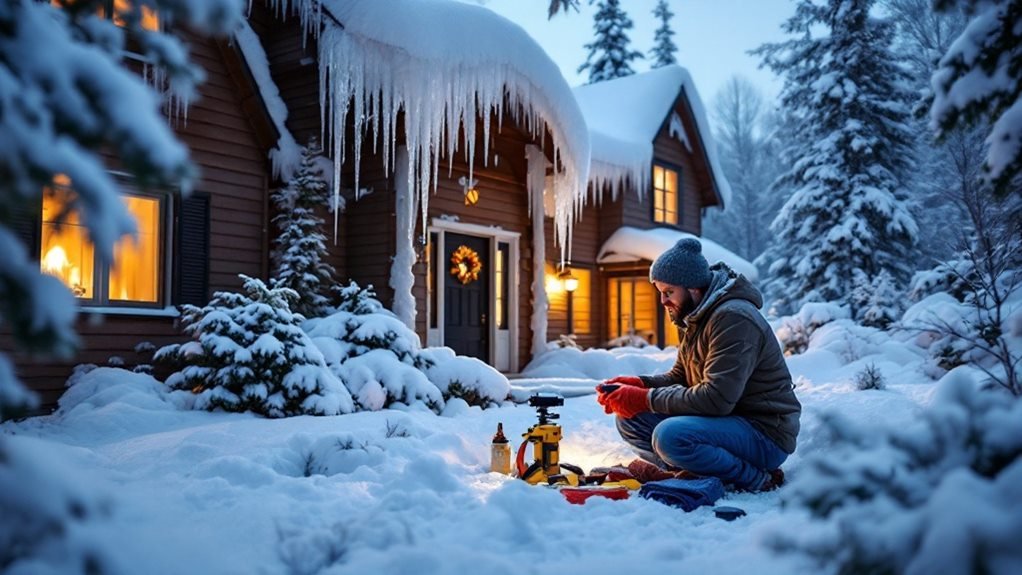
When temperatures plummet and you've got a nagging feeling that your pipes might freeze, having a solid plan for emergency measures is crucial. You don't want to play the waiting game when it comes to water damage. Here's a quick list of emergency fixes that'll keep you ahead of the game:
- Emergency Kit: Stock up on necessities like a space heater, towels, and a hairdryer. You'll be glad to have them handy.
- Insulate: Wrap any exposed pipes with insulation or even old blankets. It's not a fashion statement, but it works!
- Drip, Drip, Drip: Let your faucets drip slightly. A little movement can make a big difference in preventing freezing.
- Open Cabinet Doors: If you've got pipes under sinks, open those cabinet doors. This lets warm air circulate and keeps the chill at bay.
Professional Plumbing Services
While you can take many precautions to prevent frozen pipes, sometimes professional plumbing services are necessary to address issues that arise. If you're facing a plumbing emergency, don't hesitate to call in the pros. They've got the tools, expertise, and a sense of humor to tackle any frosty fiasco.
Professional plumbers can perform thorough plumbing maintenance to help you avoid future headaches. They'll inspect your pipes, insulate vulnerable areas, and guarantee your system is up to par. Think of them as your home's winter armor against pipe disasters—just without the cape (though that might be a fun addition).
When the temperature drops and your pipes decide to play hide and seek with water, emergency repairs become essential. A quick call to a licensed plumber can save you from a potential indoor water park situation. They'll quickly diagnose the problem, make necessary repairs, and even offer tips to keep your plumbing snug and warm during the next cold snap.
Frequently Asked Questions
How Can I Identify Vulnerable Pipes in My Home?
To identify vulnerable pipes, check areas with little insulation, like basements and attics. Look for uninsulated sections and wrap them with pipe insulation. Don't let your pipes shiver like scared kittens; keep 'em warm!
What Temperature Should I Keep My Home During Winter?
Think of your home like a cozy bear den. To keep things snug during winter, set your thermostat around 68°F. Consider these ideal thermostat settings and winter heating tips for maximum comfort and energy efficiency.
Can I Use Regular Tape Instead of Heat Tape?
Using regular tape instead of heat tape isn't wise. You need heat tape alternatives designed for insulation. Insulation options, like foam or heated sleeves, keep pipes cozy, ensuring they don't freeze—no one wants a chilly surprise!
How Often Should I Check My Pipes During Winter?
You wouldn't ignore a pet's needs, right? Check your pipes at least once a month during winter. Incorporate pipe insulation tips into your winter maintenance routines to keep everything flowing smoothly and avoid icy surprises!
Are There Specific Pipe Materials More Prone to Freezing?
Some materials, like copper and PVC, have high thermal conductivity, making 'em more prone to freezing. To combat this, use pipe insulation—it's your best buddy against chilly temps that'll turn your pipes into ice cubes!
Conclusion
By taking proactive precautions against frozen pipes, you can protect your property from potential perils. Insulating your plumbing, maintaining warmth, and monitoring temperatures are simple yet significant steps. Don't let blustery winter winds wreak havoc on your home—be vigilant and prepared. If you suspect a problem, act swiftly to avoid costly consequences. With these protective practices, you'll safeguard your sanctuary and guarantee your space stays safe and sound throughout the chilly season.

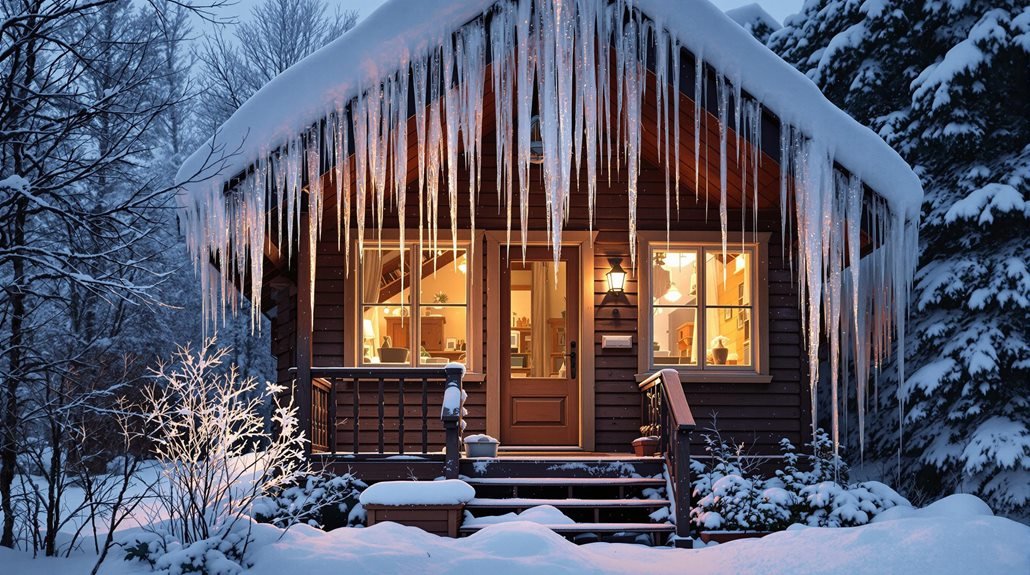
Recent Comments